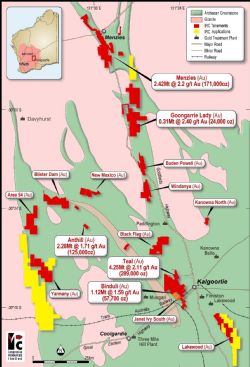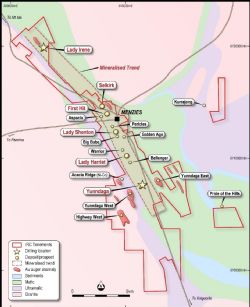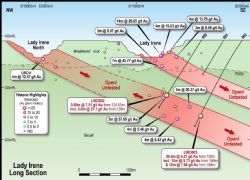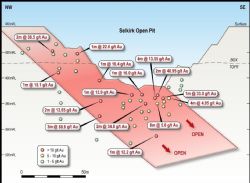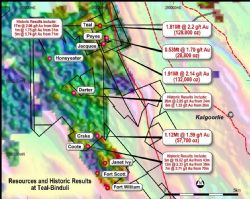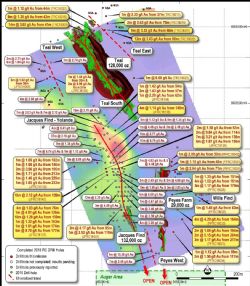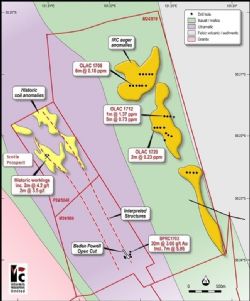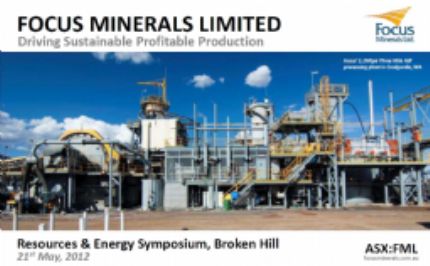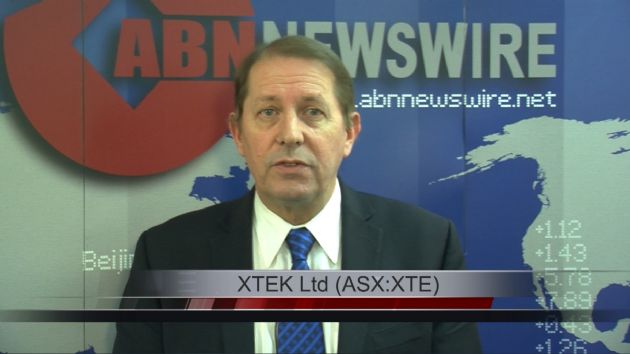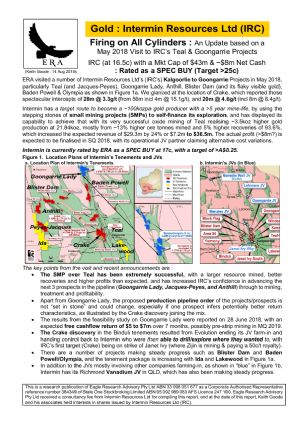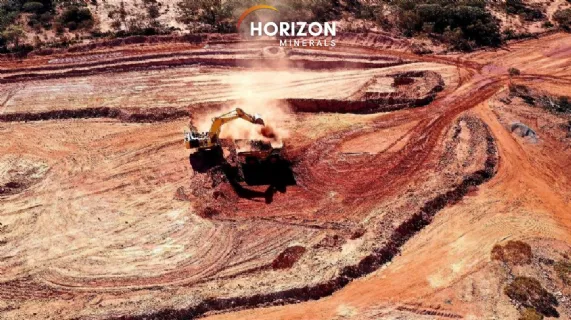
2019 Drilling Program Commences
Perth, Mar 20, 2019 AEST (ABN Newswire) - Intermin Resources Limited ( ASX:IRC) ("Intermin" or the "Company") is pleased to announce the commencement of the 2019 regional exploration drilling program. The initial 11,000m program will focus on regional projects in the Kalgoorlie and Menzies regions following up results from the 2016, 2017 and 2018 programs.
ASX:IRC) ("Intermin" or the "Company") is pleased to announce the commencement of the 2019 regional exploration drilling program. The initial 11,000m program will focus on regional projects in the Kalgoorlie and Menzies regions following up results from the 2016, 2017 and 2018 programs.
HIGHLIGHTS
- New discovery and resource extension drilling has commenced at Lady Irene as part of the 2019 Kalgoorlie and Menzies regional program
- Initial 11,000m program planned for the March and June quarters will also follow up results from Binduli, Teal East, Olympia, Scotia and Windanya at Kalgoorlie and Lady Irene and Selkirk at Menzies
- The drilling at Binduli will focus on the three high priority targets at Coote, Darter and Honeyeater following on from the highly successful drilling results from the Crake prospect
- At Teal, follow up drilling to the east of the completed Teal open pit testing extensions to recent results including 14m at 3.02g/t Au from 41m and 12m at 3.43g/t Au from 96m
- At Scotia, Olympia and Windanya, drilling will follow up results from the regional program completed in 2017 and test a number of historic prospects
- Drilling in Menzies will follow up recent high grade results at Lady Irene including:
o 39.3m @ 4.27 g/t Au from 159m including 10m @ 5.73 g/t Au from 160m and 12m @ 7.68 g/t Au from 184m
o 3.95m @ 7.51 g/t Au from 124m including 0.6m @ 27.7 g/t Au from 128m
- Drilling at Selkirk, part of the Menzies area, will test depth extensions and follow up on drilling results completed by Intermin in 2016 including:
o 3m @ 88.62g/t Au from 84m including 2m @ 118.57g/t Au from 84m
o 1m @ 15.10g/t Au from 40m and 1m @ 16.41g/t Au from 50m
- An aircore program will also be completed testing a number of new targets across the entire tenement portfolio at Menzies, Goongarrie, Windanya, Black Flag, Area 54, Yarmany, Binduli East, Kanowna North and Lakewood
- The main part of the 2019 drill program will be aligned with the intended implementation (subject to MacPherson shareholder and Court approval) of the proposed merger with MacPhersons Limited ( ASX:MRP) and the intended completion of negotiations, formal documentation and necessary regulatory approvals for the potential acquisition of the Coolgardie Gold Project from Focus Minerals Limited (
ASX:MRP) and the intended completion of negotiations, formal documentation and necessary regulatory approvals for the potential acquisition of the Coolgardie Gold Project from Focus Minerals Limited ( ASX:FML)
ASX:FML)
- Results from the initial program are expected in the June Quarter 2019
Commenting on the commencement of drilling, Intermin Managing Director Mr Jon Price said:
"The initial regional exploration program will focus on a number of targets that had limited work completed in 2018 as we focussed on resource extensions at our core project areas south of Teal, Anthill, Blister Dam and Crake. Of particular interest will be the follow up work at Lady Irene in the Menzies area and the testing of high priority targets at Binduli which have the potential to play a significant part in our future development pipeline".
"The exploration team have done an excellent job on both target generation and resource growth and we look forward to releasing initial results of the program in the June Quarter".
Menzies project area
The Menzies project area is located 100km north of Kalgoorlie Boulder (see Figures 1 and 3 in link below) and was recently returned to Intermin on a 100% basis as announced to the ASX on 7 February 2019. The current Mineral Resource Estimate for Menzies stands at 2.42Mt at 2.20g/t Au for 171,310 ounces at a 1g/t Au lower cut-off grade.
Menzies is located in the Eastern Goldfields Province of the Archaean Yilgarn Craton (see Figures 1 and 2 in link below). The greenstone belt divides at Menzies into a western section continuing to the northwest and an eastern section continuing northwards to Twin Hills. The greenstone sequence consists of a lower ultramafic formation to the west overlain by meta-sedimentary rocks which are overlain by mafic intrusive and extrusives to the east. Included in the greenstone belt are the major shear zones, the Menzies Shear Zone and the Moriarty Shear Zone, which impart a strong foliation and lineation to the underlying rock.
The Menzies Shear Zone can be traced southwards to the Bardoc Tectonic Zone approximately 50km south. Metamorphic grade is high in the amphibolite facies with porphyroblastic grain textures, marked schistosity and mineral lineations.
A southerly plunging fabric is apparent in the Menzies area, where well foliated basalts and sedimentary rocks have economic gold significance, as do the mafic/ultramafic contacts. In general ore zones have shallow westerly dips. Alteration assemblages, comprising biotite, silica, pyrrhotite, pyrite, galena, sphalerite, arsenopyrite and chalcopyrite are typical in areas of stronger gold mineralisation. Cross cutting features and felsic porphyry intrusives are also important in terms of hosting and stoping gold mineralisation.
As announced to the ASX on 19 February 2019, results from the most recent drilling included significant results at the Lady Irene prospect (see Figures 2 and 3 in link below) including:
- 39.3m @ 4.27 g/t Au from 159m including 10m @ 5.73 g/t Au from 160m and 12m @ 7.68 g/t Au from 184m (LIRD003)
- 3.95m @ 7.51 g/t Au from 124m including 0.6m @ 27.7 g/t Au from 128m (LIRD002)
The current program aims to improve the conceptual geometry of the quartz vein recorded in LIRD003 by testing adjacent areas for width and grade.
A small program will also be completed at the Selkirk prospect which was a small, historic high grade underground mine producing 5,000t @ 24.0 g/t Au for 3,858oz. Open cut mining in the 1990's produced 42,000t @ 4.60 g/t Au for 10,070oz. Recent work by Intermin in 2015-2016 identified encouraging high grade potential beneath the pit with intercepts including 3m @ 88.62 g/t Au from 84m, 1m @ 15.10 g/t Au from 40m and 1m @ 16.41g/t Au from 50m. The Selkirk mineralisation is still regarded as being open at depth (see Figure 4 in link below).
Binduli Project area
The 100% owned Binduli project area is located 9km west of Kalgoorlie-Boulder (see Figures 1 and 5 in link below) with over 8,000m of drilling completed in 2018, predominantly at the Crake prospect.
Significant downhole RC intercepts reported from the drilling in 2018 included:
- 23m @ 4.16 g/t Au from 61m including 3m @ 20.73g/t Au from 66m (BRC18020)
- 13m @ 4.10g/t Au from 65m including 2m @ 18.53g/t Au from 75m (BRC18036)
- 18m @ 3.13 g/t Au from 70m (BRC18043)
- 15m @ 2.75 g/t Au from 27m (BRC18069)
- 9m @ 4.38 g/t Au from 39m (BRC18079)
- 15m @ 1.96 g/t Au from 75m (BRC18029)
- 12m @ 1.75 g/t Au from 45m (BRC18057)
- 8m @ 2.51 g/t Au from 106m (BRC18018)
As announced to the ASX on 12 March 2019, the new data was used to compile a detailed independent Mineral Resource Estimate compliant with the JORC 2012 Code. The Mineral Resource for Crake stands at:
- 1.12Mt @ 1.59 g/t Au for 57,700 ounces at a 1.0 g/t Au lower grade cut-off
The geology at Crake is similar to the 390,000oz Janet Ivy open pit (see Figure 5 in link below), located approximately 1,500m to the south, where the gold is hosted in a structurally controlled feldspar porphyry. At the nearby Fort William and Fort Scott open pits, where over 100,000oz have been produced to date (see Figure 5 in link below), gold is hosted within sheared units of volcanics and clastic sediments.
At Crake, the gold mineralisation strikes NW and dips shallowly to the SW. A southerly plunge is tentatively interpreted. The gold lodes are often tabular shaped and 20m thick but can blow out to >60m width. High grade shoots appear to result from intersecting structures. The Crake drilling focussed on a mineralised, variably altered pink porphyry with minor amounts of pyrite and magnetite. Higher grades usually coincide with stronger pyrite mineralisation (up to 3% by volume). There is little correlation between gold and magnetite.
The current program will focus on the three high priority drilling targets at Coote, Darter and Honeyeater and aims to test and confirm historic gold intercepts.
The Coote prospect is located 700m SW of Crake and is offset along strike of the Janet Ivy deposit. Similar to Crake and Janet Ivy, it's believed the Coote mineralisation lies within a porphyry host. Historic results include 5m @ 19.62 g/t Au from 43m, 12m @ 2.33 g/t Au from 38m and 7m @ 2.71 g/t Au from 70m. Four RC holes have been planned to test Coote.
The Darter prospect is located 3.4km NNW of Crake and has several old shafts along a porphyry felsic volcanic contact. The shafts have been drill tested by previous workers and recorded an encouraging 20m @ 2.85 g/t Au and 7m @ 2.71 g/t Au. Five RC holes are planned to test the workings (see Figure 6 in link below) and follow up bottom of the hole mineralisation (1.00 g/t Au and 3.29 g/t Au) recorded from old air core holes located 200m-300m south.
About 800m -1500m NW of Darter, drilling will test two new targets within a weathered Intermediate volcanic rock that contains anomalous historic RAB drill holes (6m @ 2.20 g/t Au and 12m @ 1.77 g/t Au). Five holes have been planned.
At the Honeyeater prospect, two RC holes have been designed to confirm mineralisation associated with historic intercepts (2m @ 6.50 g/t Au from 62m and 4m @ 5.93 g/t Au from 119m). Should the Binduli scout drilling program be successful, Stage 2 follow up drilling will be undertaken immediately.
Teal Project area
The Teal gold mine is located 12km north west of Kalgoorlie-Boulder. The geology at Teal is dominated by lower Black Flag Group rocks (felsic volcanics and sediments) with lesser amounts of porphyry and intermediate volcanics. Two main controls on gold mineralisation are linking NW and NS shears. The primary ore is typically associated with quartz and sulphides (pyrite-arsenopyrite) with faulting having displaced and pinched out some of the mineralisation.
Primary mineralisation at depth exhibits semi-refractory properties and optimal recoveries are achieved through ultra-fine grinding, pressure oxidation or roasting. The shallow oxide supergene mineralisation is free milling with recoveries typically > 94%.
In 2018, several RC holes were drilled about 120m east of the Teal pit and discovered what appears to be separate zone of significant parallel mineralisation in what is now called Teal East (see Figure 7 in link below). Better results include 9m @ 3.33 g/t Au and 12m @ 3.43 g/t Au. This new eastern lode appears to be open and warrants follow up drilling. Three RC holes have been assigned to this.
Intermin intend to steadily build up the Teal Project area global resource with several other dedicated, smaller programs that follow up the encouraging exploration results from the 2016-2018 programs e.g. Wills Find (18m @ 2.69 g/t Au and 23m @ 1.29 g/t Au), Teal West (3m @ 2.74 g/t Au), Peyes West (1m @ 10.36 g/t Au, 5m @ 2.89 g/t Au) and Yolande (37m @ 2.16 g/t Au and 7m @ 6.74 g/t Au).
Scotia - Olympia Prospect area
The Scotia prospect is 66km North of Kalgoorlie and 2km NNW of Intermin's Baden Powell project area (see Figures 1 and 8 in link below). Similar to Baden Powell, the gold mineralisation appears to be related to a porphyry-ultramafic contact. Several historic workings in the area have been tested with better results including 2m @ 4.42 g/t Au from 30m and 2m @ 3.5 g/t Au. Anomalous soils to the west of the workings were also tested by Metaliko in 2015 with an encouraging 1m @ 3.15 g/t Au from 20m being recorded. These drill holes have not been confirmed or followed up. Six RC holes are planned.
The area between Baden Powell and Scotia prospects has had little exploration. Recent auger sampling by Intermin in 2018 delineated several discrete anomalous trends that appear to link up with the two respective prospects. A dedicated aircore program will be undertaken in the June and September quarters to test this and other grass root areas.
At the Olympia prospect 2.5km north of Baden Powell (see Figures 1 and 8 in link below), Intermin conducted first pass drilling in 2017 with the best result of 1m @ 1.37 g/t Au from 68m and 5m @ 0.73g/t Au from 89m (including 2m @ 1.41 g/t Au from 89m in OLAC1712). The drilling was designed to investigate the cause of widespread gold confirmed in the earlier auger programs. The Olympia prospect sits within a highly depleted regolith, such that strongly oxidised rocks have been drilled at >100m depth. Oxide gold is typically remobilised in these environments. The deeper mineralisation at OLAC1712 indicated that the gold was in a transitional zone with small chips of quartz-pyrite veining being noted in the pan. This observation helps provide a vector for follow up drilling. One RC hole has been assigned to drill 40m west of OLAC1712 and across an interpreted gabbro/basalt contact.
Windanya area
The Windanya tenements are located about 50km NNW of Kalgoorlie and 4km SW of the Bardoc Mining Centre. Windanya sits within a package of contiguous tenements south of the Baden Powell group. The geology is located on the eastern limb of the Mt Pleasant Dome and dominated by a north striking sequence of ultramafic komatiite, dolerite, gabbro and basalt. Gold is typically found associated with 1-3m wide shear zones.
The Windanya area overall has been extensively drilled by previous explorers, however most of this drilling has been shallow (<50m depth). One follow up target (Capricorn Prospect) has been identified by Intermin in the southern Windanya area and appears to have reasonable follow up potential at depth. The historic drilling records at Capricorn shows anomalous drilling over 500m strike length with better intercepts including 3m @ 3.90 g/t Au, 3m @ 4.75 g/t Au and 1m @ 24.2 g/t Au from 86m. Intermin intends to confirm this mineralisation. Given the rich historic mines 2km to the south (but along strike and outside of IRC tenure) such as Half Mile Reef mine (24,032t @ 16.8 g/t Au), there is potential for high grade ore, six RC holes have been planned at Windanya for first pass drilling.
Regional aircore program
In addition to the RC program, a large aircore program will be completed to test regional grass roots targets identified through the 2018 project generation across the entire tenement portfolio at Menzies, Goongarrie, Windanya, Black Flag, Area 54, Yarmany, Binduli East, Kanowna North and Lakewood.
To view the release with figures, please visit:
http://abnnewswire.net/lnk/603LJ2B4
About Horizon Minerals Limited
 Horizon Minerals Limited (ASX:HRZ) is a gold exploration and mining company focussed on the Kalgoorlie and Menzies areas of Western Australia which are host to some of Australia's richest gold deposits. The Company is developing a mining pipeline of projects to generate cash and self-fund aggressive exploration, mine developments and further acquisitions. The Teal gold mine has been recently completed.
Horizon Minerals Limited (ASX:HRZ) is a gold exploration and mining company focussed on the Kalgoorlie and Menzies areas of Western Australia which are host to some of Australia's richest gold deposits. The Company is developing a mining pipeline of projects to generate cash and self-fund aggressive exploration, mine developments and further acquisitions. The Teal gold mine has been recently completed.
Horizon is aiming to significantly grow its JORC-Compliant Mineral Resources, complete definitive feasibility studies on core high grade open cut and underground projects and build a sustainable development pipeline.
Horizon has a number of joint ventures in place across multiple commodities and regions of Australia providing exposure to Vanadium, Copper, PGE's, Gold and Nickel/Cobalt. Our quality joint venture partners are earning in to our project areas by spending over $20 million over 5 years enabling focus on the gold business while maintaining upside leverage.
| ||
|



